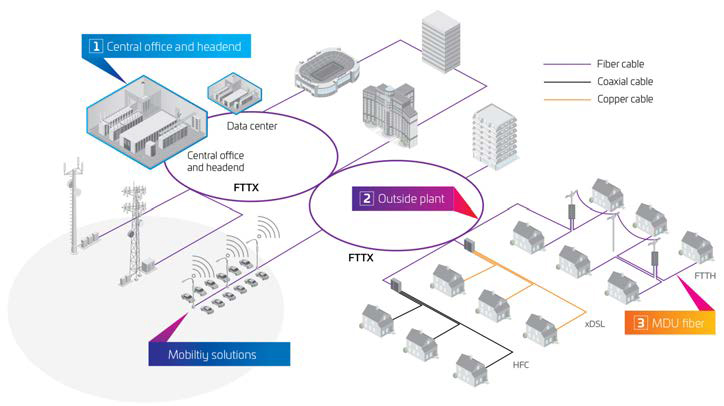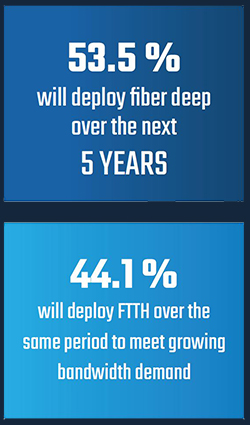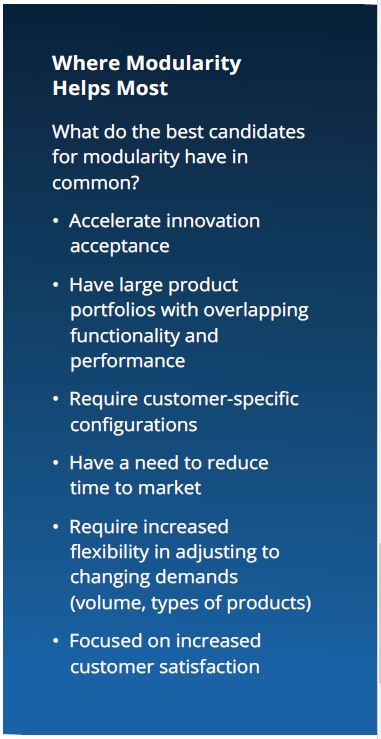
Service providers are accelerating the deployment of fiber-based network solutions that help them provide highly competitive connected experiences while preparing for a future of expanded capacity. But the fiber connectivity evolution has also resulted in several challenges for service providers. With fiber going deeper into the network, there is so much variation among enclosures and terminals that sourcing these critical connectivity devices, training technicians on their use, and deploying fiber quickly have become increasingly complex and difficult.
Fiber-to-the-home (FTTH) deployments, for example, rely on a seemingly infinite number of configuration permutations that account for variations among network segments and physical locations. Enclosures, terminals, closures, hubs, cabinets, and other connectivity devices must all be tailored for the fiber capacity, technologies, cable gauges, splice counts, connector types, mounting requirements, and environmental protection needs of their unique application.

FTTX Topography
The numbers are staggering. In its fiber connectivity portfolio, CommScope had approximately 2,500 different options for its hardened fiber terminals, including 206 types of fiber trays, 224 mounting brackets, and 155 closure domes or top covers. It’s not atypical for large service providers to have tens of thousands of fiber SKUs in inventory. And satisfying each new application required a lengthy development time and added even more unique product variations to the portfolio. This rapidly expanding product set created a natural conflict between volume and variation that stifled CommScope’s ability to meet customer needs quickly, created rigidity and complexity in its development processes, and made it difficult to scale production. These challenges presented the opportunity for a fresh approach and a better way to what’s next in FTTH connectivity.
That’s when CommScope embarked on a transformational journey, resulting in a multidisciplinary approach that is revolutionizing how CommScope brings its fiber connectivity products to market—from design to operations, ordering, and field installations. To begin this process, the company conducted a deep dive into customer needs, gathering input from over 25 global service providers and conducting multiple concept testing sessions including third-party installers to also understand how CommScope’s products were not only being used—but pushed beyond their intended use. CommScope wanted to know how service providers were stretching components to their limits and adapting its connectivity products to solve problems.
Internally, CommScope turned the development process into a company-wide, global initiative that involved employees from nearly every department: R&D, product management, field application engineering, operations, supply chain, sales, manufacturing, marketing, and customer service. This overhaul of design, production, and supply chain resulted in the creation of a modular end-to-end fiber connectivity ecosystem that CommScope calls NOVUX™. With it, CommScope has reduced components by at least 75 percent, while allowing for 50 times the configurations than are available today.
This paper details the key considerations that formed the creation of the industry’s first modular FTTH ecosystem and reviews the path CommScope followed as it transformed its fiber connectivity portfolio around the principle of modularity—and redefined its company culture in the process.
INDUSTRY TRENDS AND CHALLENGES
Three principles emerged as the foundation for a new FTTH design approach: configurability, scalability, and simplicity. These values help guide CommScope’s development while ensuring service providers can navigate current and future industry challenges and trends in an era of burgeoning demand for broadband capacity. The COVID-19 pandemic has heightened the urgency for the industry to deliver on broadband’s potential and shined a spotlight on the hurdles preventing a clear path to fiber network rollouts.
Fiber Deeper in the Network
 Fiber’s march deeper into the network is undeniable. A November 2020 Cable Fiber Outlook Survey from Heavy Reading showed that 53.5 percent of respondents say they will deploy fiber deep over the next five years and 44.1 percent said they would deploy FTTH over the same period to meet the growing bandwidth demand. The magnitude of the investment required is demonstrated by findings from the Broadband Communities 2021 Fiber Trends report: fiber passes 53.8 million U.S. homes, but only connects 22.5 million. In Europe, fiber passes 182.6 million homes, connecting only 81.9 million, according to the FTTH Council Europe.
Fiber’s march deeper into the network is undeniable. A November 2020 Cable Fiber Outlook Survey from Heavy Reading showed that 53.5 percent of respondents say they will deploy fiber deep over the next five years and 44.1 percent said they would deploy FTTH over the same period to meet the growing bandwidth demand. The magnitude of the investment required is demonstrated by findings from the Broadband Communities 2021 Fiber Trends report: fiber passes 53.8 million U.S. homes, but only connects 22.5 million. In Europe, fiber passes 182.6 million homes, connecting only 81.9 million, according to the FTTH Council Europe.
But as fiber goes deeper, the challenges increase. Diverse architectures (DAA, FTTX, FTTH, 5G and hybrids) and applications (residential, business, backhaul) require many connectivity product configurations, components, spares, and associated training and operational complexities— putting pressure on service providers’ business cases and challenging equipment vendors to create more configurable solutions.
Shortage of Skilled Labor
Deploying fiber for FTTH requires a skilled labor force, but experienced technicians are difficult to find and expensive to train. The same Heavy Reading survey showed two of the top three challenges to installing FTTH are training staff and contractors. Currently, specialized technicians work in different parts of the network: trunk, feeder, and drop. The FTTH last mile is particularly complicated, with multiple variations that include spliced, connectorized, and hardened drops. With few technicians available and a trend toward a younger demographic, the opportunity to simplify fiber connectivity has never been greater
Rapid Technology Evolution
Any solution chosen and installed today must be prepared to address not only today’s technologies, but also those of the future to come. Innovations are hitting the market more quickly than ever. Consider that since APON first entered the market around 2000, there have been over 20 new versions of PON released—essentially one new PON version per year. The older iterations are still in use, while new variations continue to be proposed. Fiber connectivity advancements such as rollable ribbon cables, multifiber connectivity, WDM, and fiber flex foils require that closures and terminals are designed to serve the present, as well as anticipate the future.
Changes in the Competitive Environment
The need to respond faster to market demand is increasingly important for service providers facing increased competition. This trend is expected to continue as service providers prioritize broadband investments and public funding for broadband increases.
This highly competitive environment is creating a sense of urgency for service providers who want to retain existing customers while attracting new ones. There is room for growth in both the U.S. and Europe. A recent study by USTelecom showed that 46% of areas in Europe have two or more competing facilities-based broadband providers. In the US, the areas in which subscribers benefit from competition between two or more broadband providers jump to 94%. For service providers, winning subscribers in these contested markets requires a network with the highest broadband capacity, fastest speed, and highest reliability. FTTH provides these advantages, assuming its deployment complexity can be mitigated so that a service provider can quickly respond to customer demands.
MODULAR DESIGN: A NEW BUT WELL-PROVEN METHOD
 CommScope examined these trends and challenges and found a common thread in their solution: the ability to offer the most configurations for connectivity with the fewest components. The company first surveyed other industries to see how they accomplished this goal, and as a result, studied “platforming”—the standardization of components—as a potential solution. In the auto industry, for example, a manufacturer might use the same undercarriage or chassis for many models of cars. Here, platforming reduces the number of unique parts but also limits the potential for product variations. In broadband, platforming raises a similar issue since certain components that particular customers depend upon would need to be eliminated with this approach.
CommScope examined these trends and challenges and found a common thread in their solution: the ability to offer the most configurations for connectivity with the fewest components. The company first surveyed other industries to see how they accomplished this goal, and as a result, studied “platforming”—the standardization of components—as a potential solution. In the auto industry, for example, a manufacturer might use the same undercarriage or chassis for many models of cars. Here, platforming reduces the number of unique parts but also limits the potential for product variations. In broadband, platforming raises a similar issue since certain components that particular customers depend upon would need to be eliminated with this approach.
CommScope then examined the principle of modularity. The key to modularity is that interfaces are standardized. Therefore, components with these interfaces can be connected in any configuration that suits a service provider’s technology and architectural requirements. This presents an elegant solution for product sets that must keep volume and variation in balance. Looking at FTTH through the lens of modular design, CommScope knew it would have to rethink and retool all its processes.
VISION OF A MODULAR FTTH ECOSYSTEM
Returning to the trends and challenges, let’s review exactly how modularity can benefit an FTTH deployment.
Enable fiber deeper in the network
Using common building blocks with standardized interfaces reduces the number of modules needed to produce more connectivity configurations to address the many unique locations and applications associated with getting fiber deeper into the network.
Deploy fiber with less skilled labor
With a modular approach to fiber connectivity, installers only need to be trained one time on the installation and assembly process, which is common across the modular system. Regardless of the configuration, an installer encounters in the field, the installation process will be easy to recognize, making the work more efficient, while simplifying training and improving quality. Additionally, there is plug-and-play connectivity thanks to the interfaces but also because once a hardened technology module is tested in the factory, it is considered reliable in the field.
Keep up with rapid technology evolution
When technology changes occur, updated modules can be easily designed and produced to accommodate them. This reduces the need to replace products in the field or to redesign entire products to address a technological advancement while making it easier to upgrade the installed base to new technologies. In addition, tested modules and interfaces do not need to be retested when used in another configuration or network segment.
Address changes in competitive environments
The increased competition requires service providers to be agile and seize new opportunities. Since there is no “one size fits all” when it comes to fiber deployments, especially in brownfield and greenfield situations, service providers need the right products in the right volume, and with enough simplicity to deploy them quickly.
